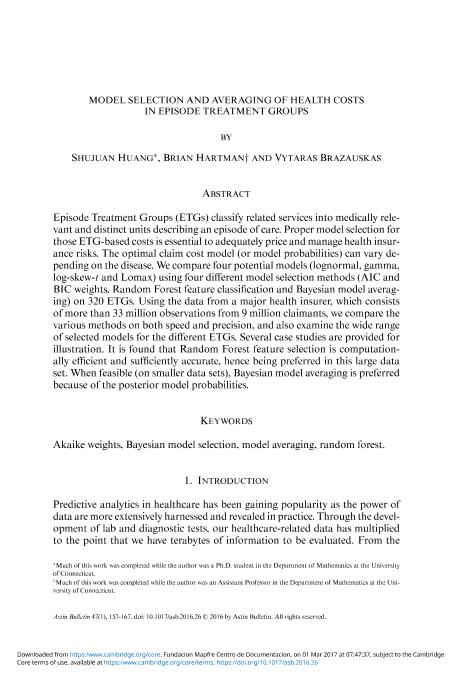Model selection and averaging of health costs in episode treatment groups

Contenido multimedia no disponible por derechos de autor o por acceso restringido. Contacte con la institución para más información.
| Tag | 1 | 2 | Valor |
|---|---|---|---|
| LDR | 00000cab a2200000 4500 | ||
| 001 | MAP20170006688 | ||
| 003 | MAP | ||
| 005 | 20170301142529.0 | ||
| 008 | 170301e20170102usa|||p |0|||b|eng d | ||
| 040 | $aMAP$bspa$dMAP | ||
| 084 | $a6 | ||
| 100 | 1 | $0MAPA20170002666$aHuang, Shujuan | |
| 245 | 1 | 0 | $aModel selection and averaging of health costs in episode treatment groups$cShujuan Huang, Brian Hartman, Vytaras Brazauskas |
| 520 | $aEpisode Treatment Groups (ETGs) classify related services into medically relevant and distinct units describing an episode of care. Proper model selection for those ETG-based costs is essential to adequately price and manage health insurance risks. The optimal claim cost model (or model probabilities) can vary depending on the disease. We compare four potential models (lognormal, gamma, log-skew-t and Lomax) using four different model selection methods (AIC and BIC weights, Random Forest feature classification and Bayesian model averaging) on 320 ETGs. Using the data from a major health insurer, which consists of more than 33 million observations from 9 million claimants, we compare the various methods on both speed and precision, and also examine the wide range of selected models for the different ETGs. Several case studies are provided for illustration. It is found that Random Forest feature selection is computationally efficient and sufficiently accurate, hence being preferred in this large data set. When feasible (on smaller data sets), Bayesian model averaging is preferred because of the posterior model probabilities. | ||
| 700 | 1 | $0MAPA20130016856$aHartman, Brian M. | |
| 700 | $0MAPA20090039018$aBrazauskas, Vytaras | ||
| 773 | 0 | $wMAP20077000420$tAstin bulletin$dBelgium : ASTIN and AFIR Sections of the International Actuarial Association$x0515-0361$g02/01/2017 Volumen 47 Número 1 - enero 2017 , p. 153-167 |

